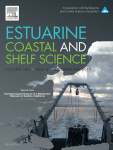Special journal issue chronicles how Bight ecosystems influenced by diversion of wastewater effluent

SCCWRP and its partners have developed a vulnerability index model that predicts how low-lying coastal wetlands across Southern California, including Los Peñasquitos Lagoon in San Diego, above, will be impacted by sea level rise over the next century.
The journal Estuarine, Coastal and Shelf Science has published a special journal issue dedicated to a series of SCCWRP-coordinated journal articles that assessed how temporarily diverting an Orange County wastewater effluent discharge closer to shore affected the nearshore ecosystem.
The nine-part special issue, published in April, chronicles the biological effects on phytoplankton and bacterial communities from moving the discharge zone for treated wastewater effluent from five miles offshore to one mile offshore. The
journal articles focus on changes in biogeochemical cycling that accompanied a sudden influx of nitrogen, which is discharged in effluent and serves as a major nutrient source for primary producers.
The studies were conducted in fall 2012 at the request of the Orange County Sanitation District, which was performing routine maintenance on its main outfall pipe. Multiple organizations were involved in the studies during the three-week diversion project.
SCCWRP helped the Sanitation District coordinate the multiple research efforts, and two of the four guest editors for the special journal issue were SCCWRP scientists. The special journal issue is titled “Tracking impacts of anthropogenic nutrient inputs in an urban coastal ecosystem during a wastewater diversion in the Southern California Bight
More news related to: Eutrophication, Ocean Acidification and Hypoxia